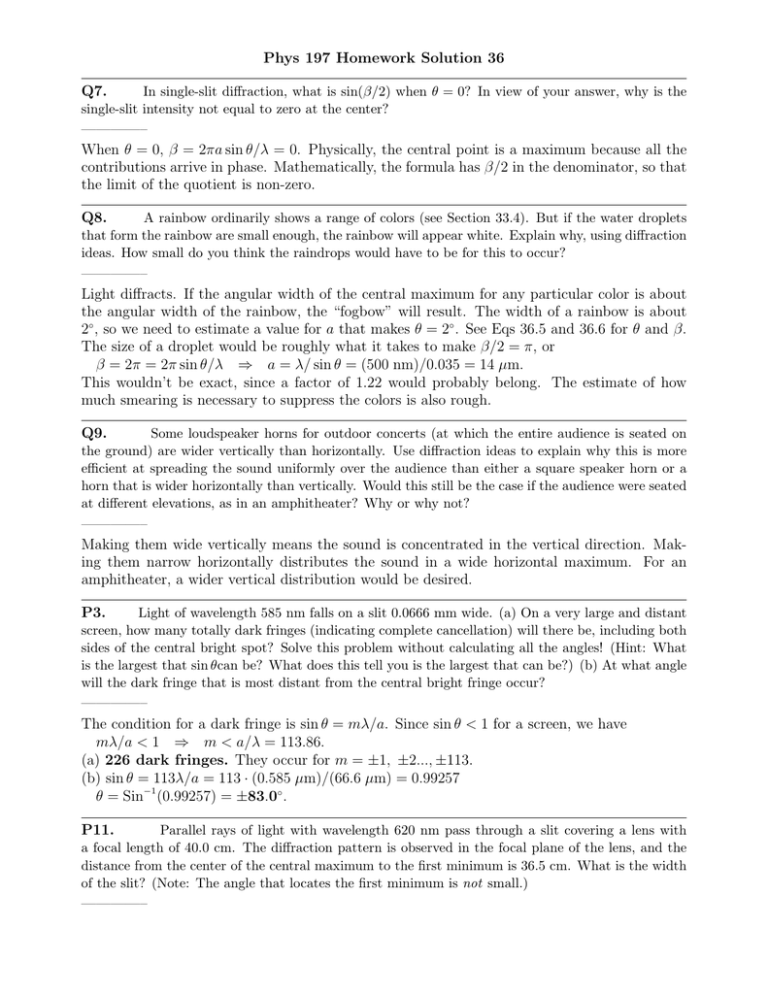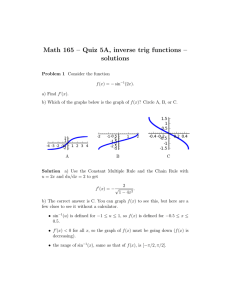Phys 197 Homework Solution 36 - University of San Diego Home
advertisement

Phys 197 Homework Solution 36
Q7.
In single-slit diffraction, what is sin(β/2) when θ = 0? In view of your answer, why is the
single-slit intensity not equal to zero at the center?
————–
When θ = 0, β = 2πa sin θ/λ = 0. Physically, the central point is a maximum because all the
contributions arrive in phase. Mathematically, the formula has β/2 in the denominator, so that
the limit of the quotient is non-zero.
Q8.
A rainbow ordinarily shows a range of colors (see Section 33.4). But if the water droplets
that form the rainbow are small enough, the rainbow will appear white. Explain why, using diffraction
ideas. How small do you think the raindrops would have to be for this to occur?
————–
Light diffracts. If the angular width of the central maximum for any particular color is about
the angular width of the rainbow, the “fogbow” will result. The width of a rainbow is about
2◦ , so we need to estimate a value for a that makes θ = 2◦ . See Eqs 36.5 and 36.6 for θ and β.
The size of a droplet would be roughly what it takes to make β/2 = π, or
β = 2π = 2π sin θ/λ ⇒ a = λ/ sin θ = (500 nm)/0.035 = 14 µm.
This wouldn’t be exact, since a factor of 1.22 would probably belong. The estimate of how
much smearing is necessary to suppress the colors is also rough.
Q9.
Some loudspeaker horns for outdoor concerts (at which the entire audience is seated on
the ground) are wider vertically than horizontally. Use diffraction ideas to explain why this is more
efficient at spreading the sound uniformly over the audience than either a square speaker horn or a
horn that is wider horizontally than vertically. Would this still be the case if the audience were seated
at different elevations, as in an amphitheater? Why or why not?
————–
Making them wide vertically means the sound is concentrated in the vertical direction. Making them narrow horizontally distributes the sound in a wide horizontal maximum. For an
amphitheater, a wider vertical distribution would be desired.
P3.
Light of wavelength 585 nm falls on a slit 0.0666 mm wide. (a) On a very large and distant
screen, how many totally dark fringes (indicating complete cancellation) will there be, including both
sides of the central bright spot? Solve this problem without calculating all the angles! (Hint: What
is the largest that sin θcan be? What does this tell you is the largest that can be?) (b) At what angle
will the dark fringe that is most distant from the central bright fringe occur?
————–
The condition for a dark fringe is sin θ = mλ/a. Since sin θ < 1 for a screen, we have
mλ/a < 1 ⇒ m < a/λ = 113.86.
(a) 226 dark fringes. They occur for m = ±1, ±2..., ±113.
(b) sin θ = 113λ/a = 113 · (0.585 µm)/(66.6 µm) = 0.99257
θ = Sin−1 (0.99257) = ±83.0◦ .
P11.
Parallel rays of light with wavelength 620 nm pass through a slit covering a lens with
a focal length of 40.0 cm. The diffraction pattern is observed in the focal plane of the lens, and the
distance from the center of the central maximum to the first minimum is 36.5 cm. What is the width
of the slit? (Note: The angle that locates the first minimum is not small.)
————–
The lens makes the rays parallel, so doesn’t really figure in the calculation. This is m = 1, so
we have
√
sin θ = 36.5/ 36.52 + 402 = 0.67405. Plug
sin θ = λ/a ⇒ a = λ/ sin θ = (0.620 µm)/0.67405 = 0.920 µm.
P15.
A slit 0.240 mm wide is illuminated by parallel light rays of wavelength 540 nm. The
diffraction pattern is observed on a screen that is 3.00 m from the slit. The intensity at the center
of the central maximum (θ = 0) is 6.00 × 10−6 W/m2 . (a) What is the distance on the screen from
the center of the central maximum to the first minimum? (b) What is the intensity at a point on the
screen midway between the center of the central maximum and the first minimum?
————–
(a) sin θ = λ/a = (0.540 µm)/(240 µm) = 0.00225 ⇒ θ = 0.1289◦ .
x = R tan θ = (3 m)(0.00225) = 6.750 mm. The small-angle approximation would have
been fine.
(b) Using the small-angle approximation, θ here will be half the previous value, or θ = 0.0645◦
and sin θ = 1.126 × 10−3 and (see Eq 36.6 p. 1196)
β = 2πa sin θ/λ = 6.2832(240 µm)(1.126 × 10−3 )/(0.540 µm) = 3.144. So, β/2 = 1.572. Plug
into Eq. 36.5:
I = I0 (sin(β/2)/(β/2))2 = (6.00 × 10−6 W/m2 ) (1.00/1.572)2 = 2.43 × 10−6 W/m2 .
P21.
Number of Fringes in a Diffraction Maximum. In Fig. 36.12c the central diffraction
maximum contains exactly seven interference fringes, and in this case d/a = 4. (a) What must the
ratio be if the central maximum contains exactly five fringes? (b) In the case considered in part
(a), how many fringes are contained within the first diffraction maximum on one side of the central
maximum?
————–
(a) To get 5 fringes, we have the central max, then two fringes on each side. We will have the
zero of the diffraction pattern suppress the third fringe. Then
d sin θ = 3λ and a sin θ = λ, Dividing,
d/a = 3.
(b) Two complete fringes between the central max and the first zero of the diffraction pattern.
The center of fringe zero is dead on the center of the diffraction maximum.
P28.
Monochromatic light is at normal incidence on a plane transmission grating. The
first-order maximum in the interference pattern is at an angle of 8.94◦ . What is the angular position
of the fourth-order maximum?
————–
Maxima occur at d sin θ = mλ, or sin θ = mλ/d. For m = 1, θ1 = 8.94◦
sin θ4 = 4 sin θ1 = 0.6216 ⇒
θ4 = 38.4◦ .
P36.
⇒
sin θ1 = 0.1554.
Identifying Isotopes by Spectra. Different isotopes of the same element emit light at
slightly different wavelengths. A wavelength in the emission spectrum of a hydrogen atom is 656.45
nm; for deuterium, the corresponding wavelength is 656.27 nm. (a) What minimum number of slits
is required to resolve these two wavelengths in second order? (b) If the grating has 500.00 slits/mm,
find the angles and angular separation of these two wavelengths in the second order.
————–
(a) Resolving Power is defined as R = λ/∆λ, and is given by R = mN . So, the required
R = 656.4/0.18 = 3650.
N = R/m = 1825.
(b) We have m = 2 so d sin θ = 2λ. Noting that d = 2.00 µm, we have
sin θ = 2λ/d = {0.65645, 0.65627} and
θ = {41.030◦ , 41.016◦ } and ∆θ = 0.014◦ .
Google “Harold Urey.”
P51.
Thickness of Human Hair. Although we have discussed single-slit diffraction only for
a slit, a similar result holds when light bends around a straight, thin object, such as a strand of hair.
In that case, a is the width of the strand. From actual laboratory measurements on a human hair,
it was found that when a beam of light of wavelength 632.8 nm was shone on a single strand of hair,
and the diffracted light was viewed on a screen 1.25 m away, the first dark fringes on either side of
the central bright spot were 5.22 cm apart. How thick was this strand of hair?
————–
The diffraction pattern for a hair is the same as for a slit of equal width. The separation of the
dark fringes is twice
√ the distance from center to either fringe, so
sin θ = (2.61)/ 2.612 + 1252 = 0.02088. Since m = 1,
a sin θ = λ ⇒ a = (0.6238 µm)/0.02088 = 29.88 µm. Since the first dark fringes on either
side are separated
P58 Opt.
The intensity of light in the Fraunhofer diffraction pattern of a single slit is
³ sin γ ´2
I = I0
γ
where
πa sin θ
λ
(a) Show that the equation for the values of at which is a maximum is tan γ = γ. (b) Determine the
three smallest positive values of that are solutions of this equation. (Hint:You can use a trial-anderror procedure. Guess a value of and adjust your guess to bring tan γ closer to γ. A graphical solution
of the equation is very helpful in locating the solutions approximately, to get good initial guesses.)
γ=
————–
(a) Standard calculus trick - take dI/dγ and set to zero.
dI/dγ = I0 (2)(sin γ/γ)(γ cos γ − sin γ)/γ 2 .
Only two factors can be zero:
If sin γ = 0, then I = 0, so this which clearly corresponds to minima.
If (γ cos γ − sin γ) = 0, then sin γ is clearly non-zero, so these can’t correspond to minima;
hence they correspond to maxima.
γ cos γ = sin γ ⇒ γ = tan γ.
(b) From a rough sketch, we see that solutions are at γ = 0, and γ values a bit less than
{3π/2, 5π/2, 7π/2, ...} = {4.6, 7.8, 10.9, ...}. By inspection, I for γ = 0 is a maximum, provided
we define this as the limit as γ → 0. Refining the other values, we see they are at
γ = {4.4934, 7.7253, 10.9041, ...}.
This is an example of a transcendental equation, which can only be solved numerically (although
there are more efficient methods).


